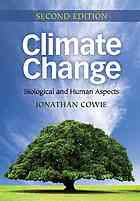
Climate change : biological and human aspects PDF
Preview Climate change : biological and human aspects
(cid:2)(cid:3)(cid:4)(cid:5)(cid:6)(cid:7)(cid:8)(cid:9)(cid:10)(cid:3)(cid:8)(cid:11)(cid:12)(cid:5)(cid:6)(cid:8)(cid:7)(cid:13)(cid:5)(cid:11)(cid:5)(cid:10)(cid:14)(cid:15) SECOND EDITION ‘An excellent contribution to the growing recognition that knowledge of biological and human systems is needed to understand climate change.’ C O – Gordon Bonan, National Center for Atmospheric Research W ‘ … readers gain an appreciation of the wide-ranging consequences of climate change with I many examples and analogies … a book a climate scientist, or any concerned citizen of the E world, should read.’ – Paul A. Dirmeyer, George Mason University (cid:2)(cid:3)(cid:4)(cid:5)(cid:6)(cid:7)(cid:8)(cid:9)(cid:10)(cid:3)(cid:8)(cid:11)(cid:12)(cid:7)(cid:8)(cid:16)(cid:5)(cid:3)(cid:6)(cid:11)(cid:8)(cid:17)(cid:13)(cid:5)(cid:11)(cid:5)(cid:10)(cid:14)(cid:15) (cid:181)(cid:3)(cid:171)(cid:3)(cid:68)(cid:3)(cid:191)(cid:3)(cid:81)(cid:72)(cid:3)(cid:87)(cid:85)(cid:72)(cid:68)(cid:87)(cid:80)(cid:72)(cid:81)(cid:87)(cid:3)(cid:82)(cid:73)(cid:3)(cid:74)(cid:79)(cid:82)(cid:69)(cid:68)(cid:79)(cid:3)(cid:70)(cid:79)(cid:76)(cid:80)(cid:68)(cid:87)(cid:72)(cid:3)(cid:70)(cid:75)(cid:68)(cid:81)(cid:74)(cid:72)(cid:3)(cid:68)(cid:81)(cid:71)(cid:3)(cid:76)(cid:81)(cid:87)(cid:72)(cid:85)(cid:68)(cid:70)(cid:87)(cid:76)(cid:82)(cid:81)(cid:86)(cid:3)(cid:90)(cid:76)(cid:87)(cid:75)(cid:3)(cid:69)(cid:76)(cid:82)(cid:79)(cid:82)(cid:74)(cid:76)(cid:70)(cid:68)(cid:79)(cid:3)(cid:86)(cid:92)(cid:86)(cid:87)(cid:72)(cid:80)(cid:86)(cid:3)(cid:171)(cid:3) everyone is likely to gain a fresh perspective or learn something new.’ – EOS C ‘ … reader-friendly, quantitative, authoritative, but above all, stimulating; the pages dare l you not to turn them over and read further.’ – The Biologist i m ‘ … an impressive endeavor … the strength of this contribution is precisely the interdisciplinary approach taken to such a multifaceted challenge.’ – Global Environmental Politics a t The second edition of this acclaimed text has been fully updated and substantially expanded to include (cid:87)(cid:75)(cid:72)(cid:3)(cid:70)(cid:82)(cid:81)(cid:86)(cid:76)(cid:71)(cid:72)(cid:85)(cid:68)(cid:69)(cid:79)(cid:72)(cid:3)(cid:71)(cid:72)(cid:89)(cid:72)(cid:79)(cid:82)(cid:83)(cid:80)(cid:72)(cid:81)(cid:87)(cid:86)(cid:3)(cid:11)(cid:86)(cid:76)(cid:81)(cid:70)(cid:72)(cid:3)(cid:83)(cid:88)(cid:69)(cid:79)(cid:76)(cid:70)(cid:68)(cid:87)(cid:76)(cid:82)(cid:81)(cid:3)(cid:82)(cid:73)(cid:3)(cid:87)(cid:75)(cid:72)(cid:3)(cid:191)(cid:3)(cid:85)(cid:86)(cid:87)(cid:3)(cid:72)(cid:71)(cid:76)(cid:87)(cid:76)(cid:82)(cid:81)(cid:12)(cid:3)(cid:76)(cid:81)(cid:3)(cid:82)(cid:88)(cid:85)(cid:3)(cid:88)(cid:81)(cid:71)(cid:72)(cid:85)(cid:86)(cid:87)(cid:68)(cid:81)(cid:71)(cid:76)(cid:81)(cid:74)(cid:3)(cid:82)(cid:73)(cid:3)(cid:87)(cid:75)(cid:72)(cid:3) e Biological and Human Aspects science of climate change, its impacts on biological and human systems, and developments in climate policy. As well as being completely revised throughout, major updates include: C (cid:135)(cid:3)(cid:3)(cid:38)(cid:82)(cid:81)(cid:86)(cid:76)(cid:71)(cid:72)(cid:85)(cid:68)(cid:69)(cid:79)(cid:72)(cid:3)(cid:72)(cid:91)(cid:83)(cid:68)(cid:81)(cid:86)(cid:76)(cid:82)(cid:81)(cid:3)(cid:82)(cid:73)(cid:3)(cid:87)(cid:75)(cid:72)(cid:3)(cid:86)(cid:72)(cid:70)(cid:87)(cid:76)(cid:82)(cid:81)(cid:86)(cid:3)(cid:82)(cid:81)(cid:3)(cid:70)(cid:79)(cid:76)(cid:80)(cid:68)(cid:87)(cid:72)(cid:3)(cid:76)(cid:80)(cid:83)(cid:68)(cid:70)(cid:87)(cid:86)(cid:3)(cid:82)(cid:81)(cid:3)(cid:72)(cid:68)(cid:85)(cid:79)(cid:92)(cid:3)(cid:86)(cid:82)(cid:70)(cid:76)(cid:72)(cid:87)(cid:76)(cid:72)(cid:86)(cid:3)(cid:76)(cid:81)(cid:3)(cid:75)(cid:76)(cid:86)(cid:87)(cid:82)(cid:85)(cid:92)(cid:15)(cid:3)(cid:68)(cid:81)(cid:71)(cid:3) biological impacts; JONATHAN COWIE h (cid:135)(cid:3)(cid:56)(cid:83)(cid:71)(cid:68)(cid:87)(cid:72)(cid:71)(cid:3)(cid:71)(cid:68)(cid:87)(cid:68)(cid:3)(cid:68)(cid:81)(cid:71)(cid:3)(cid:74)(cid:85)(cid:68)(cid:83)(cid:75)(cid:86)(cid:3)(cid:82)(cid:81)(cid:3)(cid:72)(cid:81)(cid:72)(cid:85)(cid:74)(cid:92)(cid:3)(cid:83)(cid:85)(cid:82)(cid:71)(cid:88)(cid:70)(cid:87)(cid:76)(cid:82)(cid:81)(cid:3)(cid:68)(cid:81)(cid:71)(cid:3)(cid:70)(cid:82)(cid:81)(cid:86)(cid:88)(cid:80)(cid:83)(cid:87)(cid:76)(cid:82)(cid:81)(cid:30) (cid:135)(cid:3)(cid:3)(cid:38)(cid:82)(cid:80)(cid:83)(cid:79)(cid:72)(cid:87)(cid:72)(cid:79)(cid:92)(cid:3)(cid:81)(cid:72)(cid:90)(cid:3)(cid:70)(cid:75)(cid:68)(cid:83)(cid:87)(cid:72)(cid:85)(cid:3)(cid:86)(cid:72)(cid:70)(cid:87)(cid:76)(cid:82)(cid:81)(cid:86)(cid:3)(cid:82)(cid:81)(cid:29)(cid:3)(cid:70)(cid:79)(cid:76)(cid:80)(cid:68)(cid:87)(cid:72)(cid:3)(cid:87)(cid:75)(cid:85)(cid:72)(cid:86)(cid:75)(cid:82)(cid:79)(cid:71)(cid:86)(cid:30)(cid:3)(cid:87)(cid:75)(cid:72)(cid:3)(cid:46)(cid:92)(cid:82)(cid:87)(cid:82)(cid:3)(cid:44)(cid:44)(cid:3)(cid:70)(cid:82)(cid:81)(cid:73)(cid:72)(cid:85)(cid:72)(cid:81)(cid:70)(cid:72)(cid:30)(cid:3)(cid:38)(cid:68)(cid:81)(cid:68)(cid:71)(cid:76)(cid:68)(cid:81)(cid:15)(cid:3) a Australian and New Zealand energy and climate policy; (cid:135)(cid:3)(cid:3)(cid:36)(cid:3)(cid:81)(cid:72)(cid:90)(cid:3)(cid:68)(cid:83)(cid:83)(cid:72)(cid:81)(cid:71)(cid:76)(cid:91)(cid:3)(cid:82)(cid:81)(cid:3)(cid:181)(cid:41)(cid:88)(cid:85)(cid:87)(cid:75)(cid:72)(cid:85)(cid:3)(cid:87)(cid:75)(cid:82)(cid:88)(cid:74)(cid:75)(cid:87)(cid:86)(cid:3)(cid:73)(cid:82)(cid:85)(cid:3)(cid:70)(cid:82)(cid:81)(cid:86)(cid:76)(cid:71)(cid:72)(cid:85)(cid:68)(cid:87)(cid:76)(cid:82)(cid:81)(cid:182)(cid:3)(cid:87)(cid:82)(cid:3)(cid:72)(cid:81)(cid:70)(cid:82)(cid:88)(cid:85)(cid:68)(cid:74)(cid:72)(cid:3)(cid:71)(cid:76)(cid:86)(cid:70)(cid:88)(cid:86)(cid:86)(cid:76)(cid:82)(cid:81)(cid:3) n by students and others. g Written in an accessible style, this book provides a broad review of past, present and likely future e climate change from the viewpoints of biology, ecology, human ecology and Earth system science. (cid:44)(cid:87)(cid:3)(cid:75)(cid:68)(cid:86)(cid:3)(cid:69)(cid:72)(cid:72)(cid:81)(cid:3)(cid:90)(cid:85)(cid:76)(cid:87)(cid:87)(cid:72)(cid:81)(cid:3)(cid:87)(cid:82)(cid:3)(cid:86)(cid:83)(cid:72)(cid:68)(cid:78)(cid:3)(cid:68)(cid:70)(cid:85)(cid:82)(cid:86)(cid:86)(cid:3)(cid:71)(cid:76)(cid:86)(cid:70)(cid:76)(cid:83)(cid:79)(cid:76)(cid:81)(cid:72)(cid:86)(cid:17)(cid:3)(cid:44)(cid:87)(cid:3)(cid:90)(cid:76)(cid:79)(cid:79)(cid:3)(cid:68)(cid:74)(cid:68)(cid:76)(cid:81)(cid:3)(cid:83)(cid:85)(cid:82)(cid:89)(cid:72)(cid:3)(cid:87)(cid:82)(cid:3)(cid:69)(cid:72)(cid:3)(cid:76)(cid:81)(cid:89)(cid:68)(cid:79)(cid:88)(cid:68)(cid:69)(cid:79)(cid:72)(cid:3)(cid:87)(cid:82)(cid:3)(cid:68)(cid:3)(cid:90)(cid:76)(cid:71)(cid:72)(cid:3)(cid:85)(cid:68)(cid:81)(cid:74)(cid:72)(cid:3)(cid:82)(cid:73)(cid:3) readers, from students in the life sciences who need a brief overview of the basics of climate science, to atmospheric science, geography, geoscience and environmental science students who need to (cid:88)(cid:81)(cid:71)(cid:72)(cid:85)(cid:86)(cid:87)(cid:68)(cid:81)(cid:71)(cid:3)(cid:87)(cid:75)(cid:72)(cid:3)(cid:69)(cid:76)(cid:82)(cid:79)(cid:82)(cid:74)(cid:76)(cid:70)(cid:68)(cid:79)(cid:3)(cid:68)(cid:81)(cid:71)(cid:3)(cid:75)(cid:88)(cid:80)(cid:68)(cid:81)(cid:3)(cid:72)(cid:70)(cid:82)(cid:79)(cid:82)(cid:74)(cid:76)(cid:70)(cid:68)(cid:79)(cid:3)(cid:76)(cid:80)(cid:83)(cid:79)(cid:76)(cid:70)(cid:68)(cid:87)(cid:76)(cid:82)(cid:81)(cid:86)(cid:3)(cid:82)(cid:73)(cid:3)(cid:70)(cid:79)(cid:76)(cid:80)(cid:68)(cid:87)(cid:72)(cid:3)(cid:70)(cid:75)(cid:68)(cid:81)(cid:74)(cid:72)(cid:17)(cid:3)(cid:44)(cid:87)(cid:3)(cid:76)(cid:86)(cid:3)(cid:68)(cid:79)(cid:86)(cid:82)(cid:3)(cid:68)(cid:3)(cid:89)(cid:68)(cid:79)(cid:88)(cid:68)(cid:69)(cid:79)(cid:72)(cid:3) reference text for those involved in environmental monitoring, conservation and policy-making seeking to appreciate the science underpinning climate change and its implications. (cid:55)(cid:75)(cid:72)(cid:3)(cid:56)(cid:81)(cid:76)(cid:87)(cid:72)(cid:71)(cid:3)(cid:49)(cid:68)(cid:87)(cid:76)(cid:82)(cid:81)(cid:86)(cid:3)(cid:40)(cid:81)(cid:89)(cid:76)(cid:85)(cid:82)(cid:81)(cid:80)(cid:72)(cid:81)(cid:87)(cid:3)(cid:51)(cid:85)(cid:82)(cid:74)(cid:85)(cid:68)(cid:80)(cid:80)(cid:72)(cid:3)(cid:11)(cid:56)(cid:49)(cid:40)(cid:51)(cid:12)(cid:3)(cid:70)(cid:76)(cid:87)(cid:72)(cid:71)(cid:3)(cid:87)(cid:75)(cid:72)(cid:3)(cid:191)(cid:3)(cid:85)(cid:86)(cid:87)(cid:3)(cid:72)(cid:71)(cid:76)(cid:87)(cid:76)(cid:82)(cid:81)(cid:3)(cid:68)(cid:86)(cid:3)(cid:82)(cid:81)(cid:72)(cid:3)(cid:82)(cid:73)(cid:3)(cid:87)(cid:75)(cid:72)(cid:3)(cid:87)(cid:82)(cid:83)(cid:3)(cid:70)(cid:79)(cid:76)(cid:80)(cid:68)(cid:87)(cid:72)(cid:3) change science books of the 21st century. www.cambridge.org/cowie2 (cid:85)(cid:202)(cid:42)(cid:156)(cid:220)(cid:105)(cid:192)(cid:42)(cid:156)(cid:136)(cid:152)(cid:204)(cid:202)(cid:195)(cid:143)(cid:136)(cid:96)(cid:105)(cid:195)(cid:202)(cid:62)(cid:152)(cid:96)(cid:202)(cid:27)(cid:42)(cid:13)(cid:20)(cid:195)(cid:202)(cid:156)(cid:118)(cid:202)(cid:62)(cid:143)(cid:143)(cid:202)(cid:119)(cid:202)(cid:125)(cid:213)(cid:192)(cid:105)(cid:195)(cid:202)(cid:118)(cid:192)(cid:156)(cid:147)(cid:202)(cid:204)(cid:133)(cid:105)(cid:202)(cid:76)(cid:156)(cid:156)(cid:142) (cid:38)(cid:82)(cid:89)(cid:72)(cid:85)(cid:3)(cid:83)(cid:75)(cid:82)(cid:87)(cid:82)(cid:29)(cid:3)(cid:139)(cid:3)(cid:55)(cid:82)(cid:80)(cid:58)(cid:68)(cid:85)(cid:74)(cid:3)(cid:18)(cid:3)(cid:54)(cid:75)(cid:88)(cid:87)(cid:87)(cid:72)(cid:85)(cid:86)(cid:87)(cid:82)(cid:70)(cid:78)(cid:17)(cid:70)(cid:82)(cid:80) (cid:38)(cid:82)(cid:89)(cid:72)(cid:85)(cid:3)(cid:71)(cid:72)(cid:86)(cid:76)(cid:74)(cid:81)(cid:3)(cid:69)(cid:92)(cid:3)(cid:36)(cid:79)(cid:76)(cid:70)(cid:72)(cid:3)(cid:54)(cid:82)(cid:79)(cid:82)(cid:90)(cid:68)(cid:92) ClimateChange BiologicalandHumanAspects SecondEdition The second edition of this acclaimed text has been fully updated and substantially expandedtoincludetheconsiderabledevelopments(sincepublicationofthefirstedi- tion)inourunderstandingofthescienceofclimatechange,itsimpactsonbiological andhumansystems,anddevelopmentsinclimatepolicy.Aswellasbeingcompletely revisedthroughout,majorupdatesinclude: Considerable expansion of the sections on climate impacts on early societies in history,andbiologicalimpacts; Updateddataandgraphsonenergyproductionandconsumption; Completelynewchaptersectionson:climatethresholds;theKyotoIIconference; Canadian,AustralianandNewZealandenergyandclimatepolicy; Anewappendixon‘Furtherthoughtsforconsideration’toencouragediscussion bystudentsandothers. Writteninanaccessiblestyle,thisbookprovidesabroadreviewofpast,presentand likelyfutureclimatechangefromtheviewpointsofbiology,ecology,humanecology andEarthsystemscience.Ithasbeenwrittentospeakacrossdisciplines.Itwillagain provetobeinvaluabletoawiderangeofreaders,fromstudentsinthelifesciences whoneedabriefoverviewofthebasicsofclimatescience,toatmosphericscience, geography, geoscience and environmental science students whoneed tounderstand the biological and human ecological implications of climate change. It is also a valuablereferencetextforthoseinvolvedinenvironmentalmonitoring,conservation and policy-making seeking to appreciate the science underpinning climate change anditsimplications. TheUnitedNationsEnvironmentProgramme(UNEP)citedthefirsteditionasone ofthetopclimatechangesciencebooksofthe21stcentury. Jonathan Cowie has spent many years conveying the views of learned societies in thebiologicalsciencestopolicy-makers,andinsciencecommunication(promotion, publishing,andpressliaison).Hisearlierpostgraduatestudiesrelatedtoenergyand the environment. He is a former Head of Science Policy and Books at the Institute of Biology (UK). He is also author of Climate and Human Change: Disaster or Opportunity?(1998). Praiseforthisedition: “A comprehensive review of the science of climate change, the impacts of climate change on biological and human systems, and their interrelatedness. An excellent contribution to the growing recognition that knowledge of biological and human systemsisneededtounderstandclimatechange.” GordonBonan,NationalCenterforAtmosphericResearch “...readersgainanappreciationofthewide-rangingconsequencesofclimatechange withmanyexamplesandanalogies...itisabookaclimatescientist,oranyconcerned citizenoftheworld,shouldread.” PaulA.Dirmeyer,GeorgeMasonUniversity PraisefortheFirstEdition: “...a fine treatment of global climate change and interactions with biological sys- tems...everyoneislikelytogainafreshperspectiveorlearnsomethingnew.” EOS “...reader-friendly,quantitative,authoritative,butaboveall,stimulating;thepages dareyounottoturnthemoverandreadfurther.” TheBiologist “...measured, informative, balanced, scientifically sound, and as up-to-date as a bookcanpossiblybeinthesedaysofrapidinformationaccretion.” BulletinoftheBritishEcologicalSociety “There issomuch togain fromCowie’s book...I know of noother source...that bringstogetherthebreadthanddepthofmaterialthatthisbookdoes....thebottom lineisthatanyonewhowantstounderstandclimatechangeanditsimpacts...should buythisbook....Cowiedoesabrilliantjobofweavingtogethertheevolutionoflife withtheevolutionofEarth’sclimate.” Bioscience “...animpressiveendeavor...thestrengthofthiscontributionispreciselytheinter- disciplinaryapproachtakentosuchamultifacetedchallenge.” GlobalEnvironmentalPolitics Climate Change Biological and Human Aspects Second Edition JONATHAN COWIE cambridge university press Cambridge,NewYork,Melbourne,Madrid,CapeTown, Singapore,Sa˜oPaulo,Delhi,MexicoCity CambridgeUniversityPress 32AvenueoftheAmericas,NewYork,NY10013-2473,USA www.cambridge.org Informationonthistitle:www.cambridge.org/9781107603561 (cid:2)C JonathanCowie2007,2013 Thispublicationisincopyright.Subjecttostatutoryexception andtotheprovisionsofrelevantcollectivelicensingagreements, noreproductionofanypartmaytakeplacewithoutthewritten permissionofCambridgeUniversityPress. Firstpublished2007 Secondedition2013 PrintedintheUnitedStatesofAmerica AcatalogrecordforthispublicationisavailablefromtheBritishLibrary. LibraryofCongressCataloginginPublicationData Cowie,Jonathan. Climatechange:biologicalandhumanaspects/JonathanCowie.–2nded. p. cm. Includesbibliographicalreferencesandindex. ISBN978-1-107-60356-1(paperback) 1.Climaticchanges–History. 2.Paleoclimatology. 3.Climaticchanges–Environmentalaspects. 4.Humanbeings–Effectofenvironmenton. 5.Physicalanthropology. 6.Massextinctions. I.Title. QC903.C69 2013 551.6–dc23 2012013138 ISBN978-1-107-60356-1Paperback CambridgeUniversityPresshasnoresponsibilityforthepersistenceoraccuracyofURLsforexternalor third-partyinternetwebsitesreferredtointhispublicationanddoesnotguaranteethatanycontenton suchwebsitesis,orwillremain,accurateorappropriate. InmemoryofHarryHarrison Makingroom (12thMarch1925–15thAugust2012) Contents Figures pagexiii Acknowledgementsforthefirstedition xix Acknowledgementsforthesecondedition xxi Introduction 1 1. Anintroductiontoclimatechange 4 1.1 Weatherorclimate 5 1.2 Thegreenhouseeffect 5 1.3 Thecarboncycle 14 1.4 Naturalchangesinthecarboncycle 23 1.5 Pacemakeroftheglacial–interglacialcycles 24 1.6 Non-greenhouseinfluencesonclimate 31 1.7 Thewatercycle,climatechangeandbiology 33 1.8 Fromtheorytoreality 35 1.9 References 37 2. Principalindicatorsofpastclimates 40 2.1 Terrestrialbioticclimaticproxies 42 2.1.1 Tree-ringanalysis(dendrochronology) 42 2.1.2 Isotopicdendrochronology 45 2.1.3 Leafshape(morphology) 47 2.1.4 Leafphysiology 48 2.1.5 Pollenandsporeanalysis 49 2.1.6 Speciesasclimateproxies 52 2.2 Marinebioticclimaticproxies 54 2.2.1 18OIsotopeanalysisofforamsandcorals 54 2.2.2 Alkenoneanalysis 58 2.3 Non-bioticindicators 59 2.3.1 Isotopicanalysisofwater 59 2.3.2 Boreholes 61 2.3.3 Carbondioxideandmethanerecordsaspalaeoclimaticforcing agents 61 2.3.4 Dustasanindicatorofdry–wethemisphericclimates 62 2.4 Otherindicators 62 2.5 Interpretingindicators 63 2.6 Conclusions 63 2.7 References 64 vii viii Contents 3. Pastclimatechange 66 3.1 EarlybiologyandclimateoftheHadeanandArcheaeneons (4.6–2.5bya) 66 3.1.1 Thepre-bioticEarth(4.6–3.8bya) 66 3.1.2 TheearlybioticEarth(3.8–2.3bya) 67 3.2 Majorbio-climaticeventsoftheProterozoiceon(2.5–0.542bya) 71 3.2.1 Earthintheanaerobic–aerobictransition(2.6–1.7bya) 71 3.2.2 TheaerobicEarth(from1.7bya) 74 3.3 Majorbio-climaticeventsofthepre-QuaternaryPhanerozoic (542–2mya) 80 3.3.1 Late-Ordovicianextinction(455–435mya) 80 3.3.2 Late-Devonianextinction(365–363.5mya) 81 3.3.3 Vascularplantsandtheatmosphericdepletionofcarbon dioxide(350–275mya) 81 3.3.4 Permo–Carboniferousglaciation(330–250mya) 84 3.3.5 End-Permianextinction(251mya) 85 3.3.6 End-Triassicextinction(205mya) 87 3.3.7 Toarcianextinction(183mya) 88 3.3.8 Cretaceous–Tertiaryextinction(65.5mya) 89 3.3.9 TheEocene(55–34mya)andtheInitialEoceneThermal Maximum(∼55mya) 92 3.3.10 Eocene–Oligoceneextinction(approximately35mya;or 33.9mya?) 106 3.3.11 Late-MioceneexpansionofC grasses(14–9mya) 107 4 3.4 Summary 112 3.5 References 113 4. TheOligocenetotheQuaternary:climateandbiology 119 4.1 TheOligocene(33.9–23.03mya) 119 4.2 TheendMiocene(9–5.3mya) 121 4.3 ThePliocene(5.3–2.6mya) 122 4.4 Thecurrenticeage 126 4.5 Thelastglacial 132 4.5.1 Overviewoftemperature,carbondioxideandtiming 132 4.5.2 Iceandsealevel 135 4.5.3 Temperaturechangeswithintheglacial 135 4.5.4 Biologicalandenvironmentalimpactsofthelastglacial 147 4.6 Interglacialsandthepresentclimate 156 4.6.1 Previousinterglacials 156 4.6.2 TheAllerød,BøllingandYoungerDryas(14600–11600 yearsago) 160 4.6.3 TheHolocene(11700yearsago–theIndustrialRevolution) 166 4.6.4 Biologicalresponsetothelastglacial,LGMandHolocene transition 178 4.7 Summary 189 4.8 References 190 ix Contents 5. Presentclimateandbiologicalchange 198 5.1 Recentclimatechange 198 5.1.1 ThelatterhalfoftheLittleIceAge 198 5.1.2 20th-centuryclimate 202 5.1.3 21st-centuryclimate 203 5.1.4 TheHoloceneinterglacialbeyondthe21stcentury 203 5.1.5 Holocenesummary 207 5.2 HumanchangearisingfromtheHoloceneclimate 208 5.2.1 Climaticimpactsonearlyhumancivilisations 208 5.2.2 TheLittleIceAge’shumanimpact 216 5.2.3 Increasing20th-centuryhumanclimaticinsulation 224 5.3 Climateandbusinessasusualinthe21stcentury 225 5.3.1 TheIPCCBusiness-as-Usualscenario 225 5.3.2 UncertaintiesandtheIPCC’sconclusions 240 5.4 Currenthumaninfluencesonthecarboncycle 249 5.4.1 Carbondioxide 250 5.4.2 Methane 253 5.4.3 Halocarbons 256 5.4.4 Nitrousoxide 256 5.5 References 257 6. Currentwarmingandlikelyfutureimpacts 262 6.1 Currentbiologicalsymptomsofwarming 262 6.1.1 Currentborealdendrochronologicalresponse 262 6.1.2 Currenttropicalrainforestresponse 264 6.1.3 Somebiologicaldimensionsoftheclimaticchangefingerprint 266 6.1.4 Phenology 273 6.1.5 Biologicalcommunitiesandspeciesshift 278 6.2 Casestudy:climateandnaturalsystemsintheUSAandCanada 297 6.3 Casestudy:climateandnaturalsystemsintheUK 312 6.4 Casestudy:climateandnaturalsystemsinAustralasia 324 6.5 Biologicalresponsestogreenhousetrendsbeyondthe21stcentury 328 6.6 Possiblesurpriseresponsestogreenhousetrendsinthe21stcentury andbeyond 329 6.6.1 Extremeweatherevents 330 6.6.2 Greenhousegases 333 6.6.3 Sea-levelrise 334 6.6.4 Methanehydrates(methaneclathrates) 342 6.6.5 Volcanoes 346 6.6.6 Oceanicandatmosphericcirculation 349 6.6.7 Oceanacidity 353 6.6.8 Climatethresholds 355 6.6.9 Theprobabilityofsurprises 358 6.7 References 359
